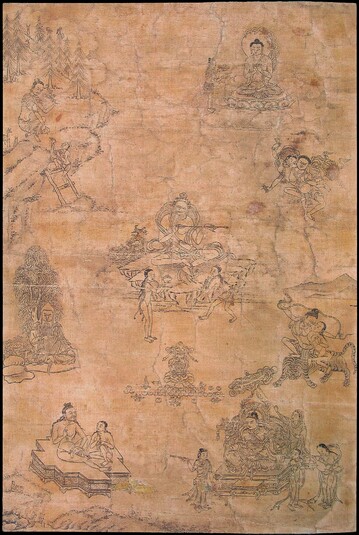
Item: Indian Adept (siddha) - (multiple figures)
| Origin Location | Tibet |
|---|---|
| Date Range | 1700 - 1799 |
| Lineages | Karma (Kagyu) and Buddhist |
| Size | 24.13x21.59cm (9.50x8.50in) |
| Material | Ground Mineral Pigment on Cotton |
| Collection | Rubin Museum of Art |
| Catalogue # | acc. #C2002.43.2 |
| Painting School | Palpung / Situ |
Classification: Person
The Eight Great Indian Adepts (Mahasiddha): an early description of each of the siddha was composed in verse by Dolpopa Sherab Gyaltsen (1292-1361) naming and prioritizing the siddha as: Nagarjuna, Indrabhuti, Dombi Heruka, Saraha, Ghantapa, Kukkuripa, Luipa, and Padmavajra. (Tibetan Text in Pdf Format).
At the center of this painting is Saraha followed by Nagarjuna at the top right. Below that and circling clockwise are Ghantapa, Dombi Heruka, Indrabhuti, Luipa, Kukkuripa and Padmavajra.
In the center is the Brahmin Saraha holding an arrow with both hands and accompanied by two female attendants. At the top right is Arya Nagarjuna with his hands in the gesture of teaching and his head adorned with a canopy of seven snakes, and a forest goddess offering a bowl of nectar. Vajra Ghantapa is ringing a vajra and bell while flying into the air with his consort. Dombi Heruka with his arms outstretched holds a snake while riding on the back of an emanated tiger and gazing at his consort. King Indrabhuti sits atop a lavish throne and is attended upon by four servants. Luipa is sitting on a raised platform with his consort and both are enjoying a meal of fish guts. Kukkuripa sits on a mat beneath a tree while embracing his drunk dakini consort in the form of a shaggy dog. Padmavajra sits eating fruit on the side of a cliff at the edge of a forest approachable only by ladder as an attendant brings supplies.
The Situ Panchen Chokyi Jungne 18th century Palpung paintings of the Eight Siddhas replace the siddha Luipa with Lawapa.
(For more information on Dolpopa see: The Buddha From Dolpo, A Study of the Life and Thought of the Tibetan Master Dolpopa Sherab Gyaltsen by Cyrus Stearns. State University of New York Press, 1999).
Jeff Watt 12-2005 [updated 12-2024]
IN PRAISE OF THE EIGHT SIDDHAS
By Dolpopa Sherab Gyaltsen (1292-1361)
(When the Omniscient One was staying at the Kyi Pug retreat cave, on the morning of the 15th day of the 9th month, having recited one round of Evam, in a clear sky appeared a swirling pavilion of rainbow light with Vajradhara and the Eight Mahasiddhas appearing in the middle. Receiving blessings and profound scriptural readings, especially that of the 'Sem Drel Kor Sum' from Indrabhuti, at that time he recited:)
Namo Gurubhyah! Dharmakaya Vajradhara having the colour of the sky,
Majestic with bone ornaments, holding a vajra and bell,
Together with the dakini consort pink Khechari;
To the supreme father Vajaradhara I praise.
[1] Nagarjuna, radiantly saffron, ornament of the Southern Continent,
With a forest goddess offering the nectar of immortality,
Having gained the attainments, teaching uninterruptedly for the benefit of others;
To the great accomplished one of supreme space I praise.
[2] Indrabhuti, the colour of bluish smoke,
Dwelling in the land of Orgyan in the manner of royalty,
Together with [his] son departing for Khechara;
To the holder of the teachings of Secret Mantra I praise.
[3] Dombi Heruka, the supreme prince,
Maroon and naked, riding on an emanated tiger,
Crossing the Ganges River seated on a mat;
To the feet of the Lord of emanated power I praise.
[4] Saraha, glorious great Brahmin, golden in colour,
Using an arrow to pierce afflictions,
Flying in the sky to the land of Shri Parvati;
To the One who has obtained the power of air-mind I praise.
[5] Great adept Ghantapa having the colour of cotton,
On a trail of light twisting in a rainbow canopy with the consort and son,
Flying into the sky ringing a vajra and bell;
To the one who has obtained the power of Khechara I praise.
[6] Glorious Kukkuripa, whitish-grey,
Madly playing with a dakini in the form of a dog,
Acquiring the attainments and without obstruction flying into the sky;
To the feet of the king of great accomplishment I praise.
[7] Royal prince, Luipa, of smoky radiance,
Acquiring the attainments eating the guts of cruel fish,
Crossing the ocean of existence [while] keeping the behaviour of a monk;
To the feet of the one holding the supreme conduct I praise.
[8] Padmavajra in the form of a layman, white in colour,
Performing the path of supreme meditation and eating only fruit,
Flying in the sky, riding an emanated tigress;
To the feet of the one who subdues evil I praise.
Through the power of this praise,
May we together, teachers, students and sponsors,
I request, at all times be free from negative obstacles
And be taken onto the positive Dharma path.
(Written at the time of the Great Omniscient one having seen the faces of the Eight Great Accomplished Ones).
[Written by Dolpopa Sherab Gyaltsen, 1292-1361. Tibetan Text. Bibliographic information: dpal jo nang ba'i zhal 'don phyogs bsgrigs bzhugs so, pages 281-283. TBRC W23923. Translated by Jeff Watt, November 2004]
Indian Adept Main Page (Mahasiddha)
Painting Style: Minimalism & Minimalist Landscape
Exhibition: Artist-in-Residence Showcase
Collection of Rubin Museum of Art (RMA): Main Page
Subject: Indian Adepts - Palpung Single Composition (8)
Subject: Eight Siddhas (Eight Great Adepts)
Subject: Eight Siddhas In One Painting
Collection of RMA: Best of Collection 2
Subject: Greyscale - Figurative & General Composition
Collection of RMA: Painting Masterworks Page
Collection of RMA: Persons Masterworks
Indian Adept: Siddha Appearance Masterworks (Painting)
Indian Adept (Mahasiddha): Painting (Late Period 17th to the Present)
Indian Adept: Mahasiddha Source Texts
Collection of RMA: Indian Adepts Masterwork Paintings





